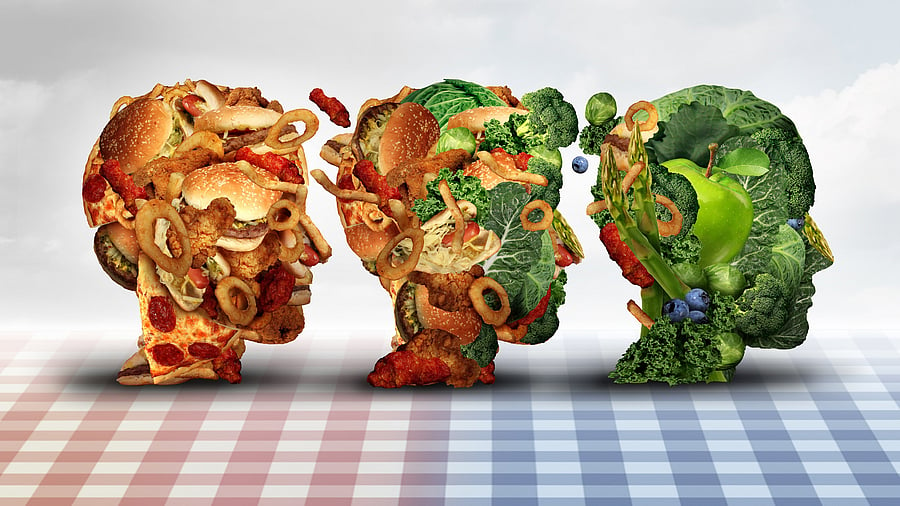
Image for representation.
Credit: iStock Photo
In a world where nutrition dominates conversations about food, we often forget that food is much more than calories and nutrients. It’s a visceral connection to emotions, culture, and identity. This understanding forms the foundation for rethinking how we approach emotional eating and mindful food choices. How can we untangle food from being a crutch for well-being and instead embrace its multifaceted role in our lives?
The band-aid for emotions
Food often becomes a convenient band-aid for emotions — an easy fix for messy, complex feelings. Whether it’s the dopamine rush of a sweet treat or the comfort of a warm meal, our body’s biochemical processes, in response to the food we eat, often create that sense of short-term relief. But over time, relying on food to mask emotions can create patterns that are hard to break. We’ve all heard the trope of eating ice cream straight from the tub after a breakup. While this may seem harmless, it highlights how food can be used to avoid confronting emotions head-on. Addressing the root cause of emotional turmoil — no matter how messy — requires courage. Food, while comforting, is not the solution.
Mindful eating
Mindful eating is about alignment — with long-term goals, with hunger and satiety cues, and with the purpose of eating. It’s not about restricting yourself but about appreciating food as an experience. It’s taking time to notice the texture, aroma, and portion sizes while expressing gratitude for the nourishment. In today’s fast-paced world, where multitasking is the norm, we often eat on autopilot. How many times have we reached the bottom of a bag of chips only to realise we didn’t even notice eating them? Mindful eating urges us to reflect:
Are we eating to meet our nutritional needs, or are we seeking comfort, familiarity, or something else entirely? This reflection helps us make choices that align with our physical and emotional needs.
What’s emotional eating?
Emotions are deeply intertwined with our eating habits, and this isn’t inherently bad. Food is a love language, a part of cultural identity, and often a source of joy. Emotional eating becomes problematic only when it’s used to avoid addressing emotions. Recognising patterns is the first step. For instance, if you find yourself reaching for food even when you’re not hungry, pause and ask: What just happened? Was I stressed, anxious, or bored?
Building an “emotional first aid kit” can be transformative. Instead of turning to food, consider alternatives: a favourite playlist, a comforting scent, or a short walk. These small actions can help address emotional triggers in healthier ways.
Breaking the cycle
Breaking the emotional eating cycle starts with understanding yourself better. Keeping an emotion journal can be a powerful tool. By labelling emotions — whether it’s anger, loneliness, or stress — you can address them in constructive ways. Remind yourself: I am feeling (emotion). What can I do instead of eating? This small act of reflection can create a pause, giving you space to respond thoughtfully rather than react impulsively.
Progress over perfection
Perfection can be paralysing. Waiting for the “perfect” time, tools, or resources to change habits often means never starting at all.
Progress, on the other hand, is about starting with what you have and learning along the way. Healthy eating doesn’t require fancy equipment or expensive ingredients — it requires intention and small, consistent steps. Begin with what you know and build from there.
Navigating industry influences
The food industry plays a significant role in shaping emotional associations with food. Marketing often ties products to celebration, victory, or relaxation, subtly encouraging emotional connections. Understanding this dynamic is crucial. As consumers, we must remember that these messages are part of a brand’s communication, not a reflection of our reality. Separating these narratives from our choices allows us to reclaim control over what makes it to our plates.
Finding harmony between food, emotions & well-being
Stop zooming in on calories, ingredients, and health halos. Unless it’s a medical or religious necessity, obsessing over every detail can lead to losing sight of the bigger picture. Food is not just about nutrition — it’s about culture, emotions, and connections. Knowing your triggers, understanding your strengths, and being aware of the forces that drive your choices can empower you to make decisions that align with your well-being. After all, food is not the enemy or the cure — it’s a part of the journey. By embracing imperfection, being mindful, and addressing emotions constructively, we can build a healthier, more balanced relationship with what’s on our plates.
(Dr Kavita Bhatnagar is a nutritionist, eating behaviour psychologist, food technologist and the author of The Power of Imperfect Eating published recently by Penguin Random House.)